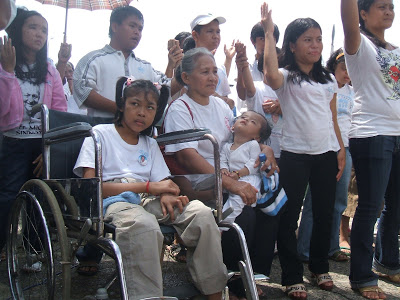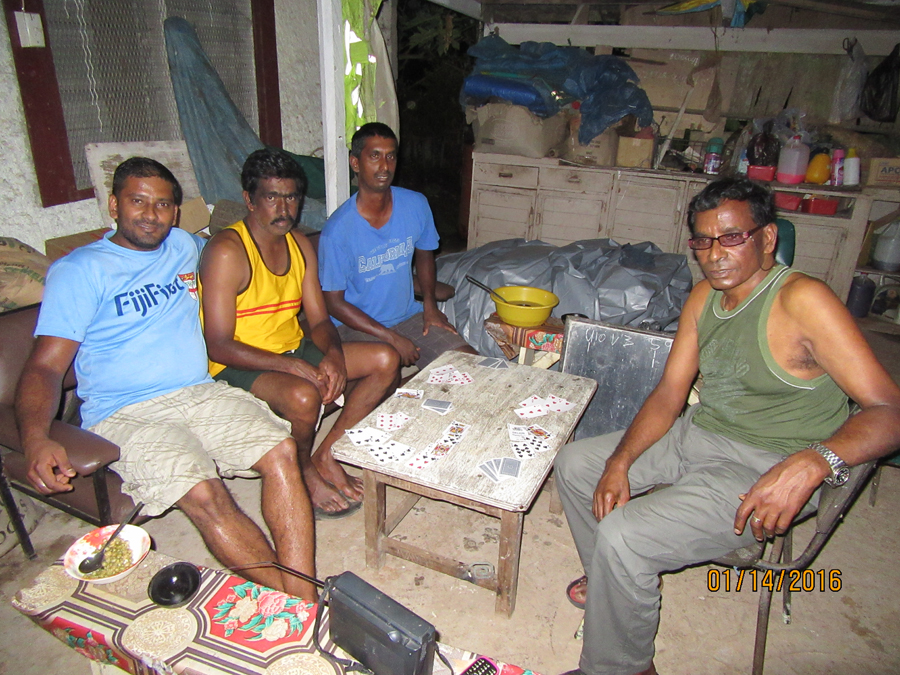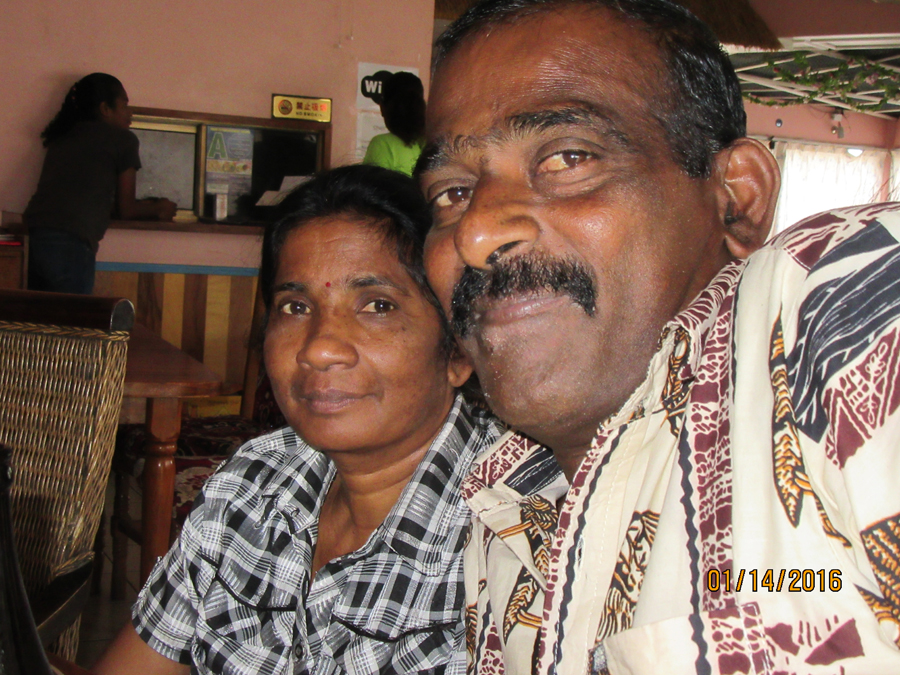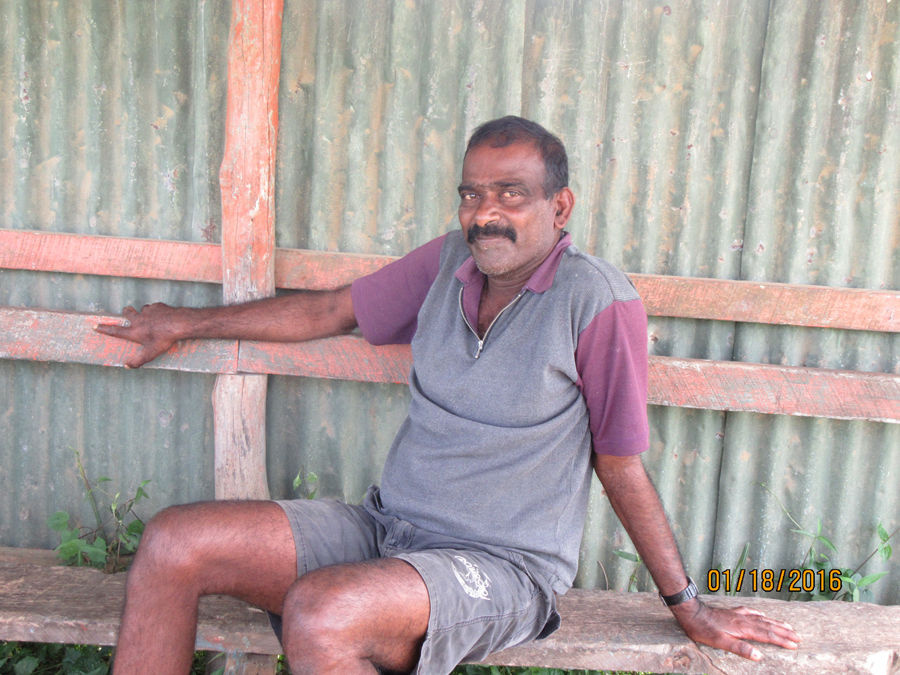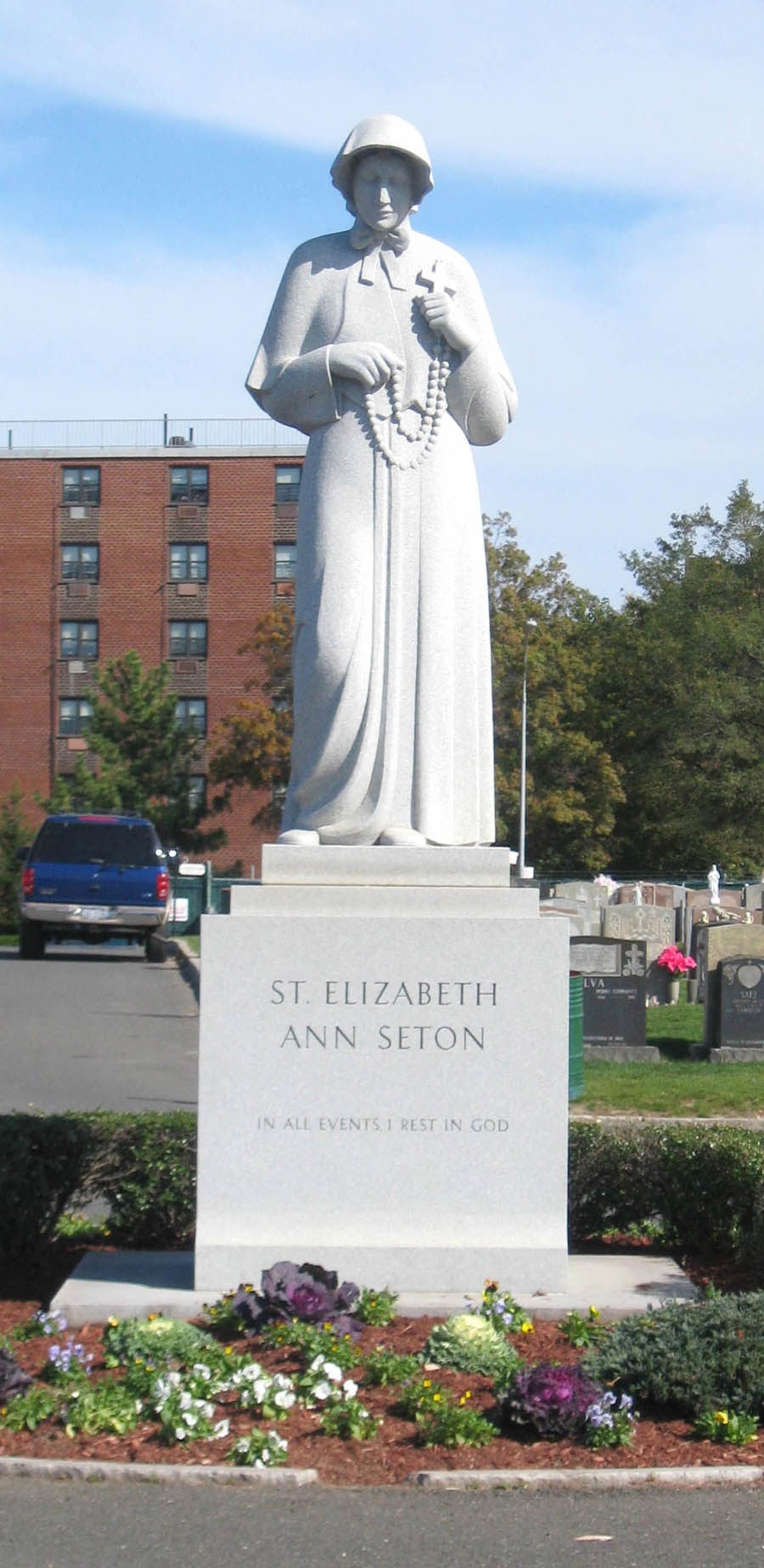Misyon Online - January-February 2017
From the Editor
At a gathering of young people in Turin on 21 June 2015 a young woman named Chiara asked Pope Francis, Often we feel disappointed in love. What does the greatness of Jesus’ love consist in? How can we experience his love?’ He answered, And now, I know that you are good and will permit me to speak sincerely. I don’t want to be a moralist but I would like to say a word that isn’t liked, an unpopular word. Sometimes the Pope must also take risks to speak the truth. Love is in works, in communicating, but love is very respectful of people, it does not use people, that is, love is chaste. And to you young people in this world, in this hedonistic world, in this world where only pleasure, having a good time, and living the good life get publicity, I say to you: be chaste, be chaste.
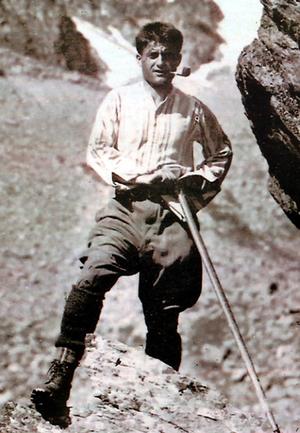
Blessed Pier Giorgio Frassati mountain climbing
Pope Francis, as Pope Benedict had done in speaking to young people in Turin on 2 May 2010, quoted the motto of one of the city’s greatest sons, Blessed Pier Giorgio Frassati (1901 – 1925): Live, don’t just get by! He came from a wealthy family. But unknown to his parents, he had lived an intense life of prayer and service to the poor of Turin alongside an active social life. He died suddenly from polio, which he had probably contracted from one of the poor whom he used to visit.
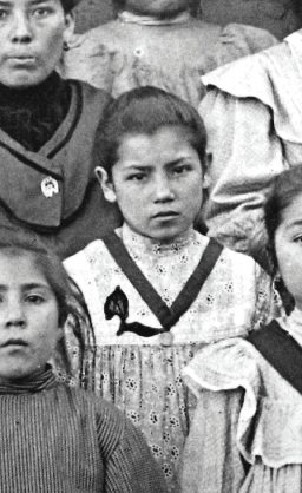
Blessed Laura Vicuña aged 10 [Wikipedia]
On 22 January Salesians celebrate the feast of Blessed Laura Vicuña, who was born in Santiago, Chile, on 5 April 1891 and died on 22 January 1904 in Argentina. We published her story in our January-February 2008 issue, A Poem of Purity: Blessed Laura Vicuña. Laura died of injuries caused by a brutal attack on her by the man her mother Mercedes was living with at the time when she repulsed his attempt to rape her.
Before she died Laura told her mother that she had offered her life to God for her conversion. Mercedes left the man and received God’s pardon in confession and started a new life.
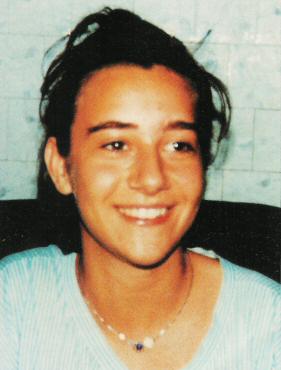
Blessed Chiara Luce Badano [Wikipedia]
In September-October 2010 we told the story of The Saint Who Failed Math, Blessed Chiara Luce Badano (1971 – 1990).
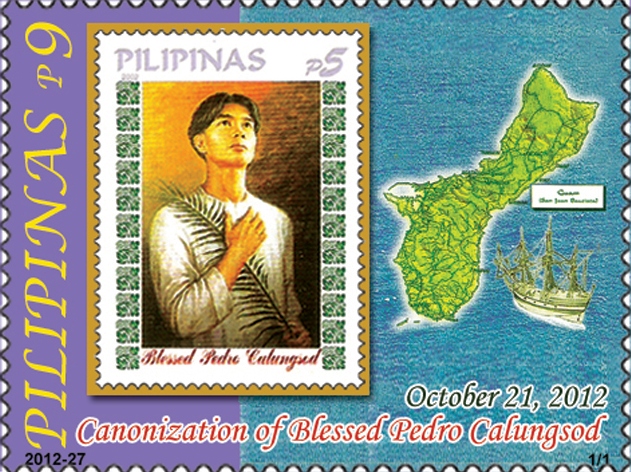
Philippine stamp to mark canonization of San Pedro Calungsod [Wikipedia]
In October 2012 Pope Benedict canonized San Pedro Calungsod (1654 -1672), a Filipino catechist, missionary and martyr.
The Church honors these young persons in order to encourage all young people to become saints, something we are called to by baptism. Pope Francis was showing the deepest respect to the young people assembled in Piazza Vittorio that day in Turin by challenging them to be chaste and to Live, don’t just get by!
Jesus asked the people one day, What father among you would hand his son a snake when he asks for a fish? Or hand him a scorpion when he asks for an egg? (Luke 11:11-12)
The Department of Education and the Department of Health in the Philippines are planning to give ‘snakes’ instead of ‘fish’, ‘scorpions’ instead of ‘eggs’ in public high schools in school year 2017-2018. Teachers will be asked to give out condoms so that minors can avoid pregnancy and sexually transmitted diseases by engaging in ‘safe sex’. Instead of calling our young people to a life of integrity, honesty and respect for self and others, respect for the beautiful gift of our sexuality through which we share in the loving creative work of God and to be expressed only within sacred marriage between man and woman, our ‘educators’ will be giving our young people the untruthful message, ‘Just don’t get caught’, the falsity that is the root of so much corruption in the Philippines.
For the authorities in the Philippines, young people are not worthy of respect.
Blessed Laura Vicuña (12), Blessed Pier Giorgio Frassati (24), Blessed Chiara Luce Badano (18) and San Pedro Calungsod (17) might think otherwise.
Hangop Kabataan
By Jocelyn Ocariza-Efhan
The author, known to her friends as ‘Jojo’, is from Dumalinao, Zamboanga del Sur. St Isidore Parish, Dumalinao, was founded by the Columbans in 1957.
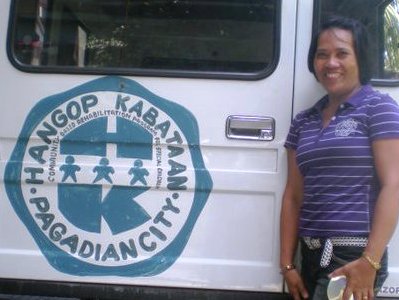
The Author
‘Paduola kanako ang mga bata . . . kay ang gingharian sa langit ila sa mga tawo nga sama kanila’ – ‘Let the children come to me . . . for the kingdom of heaven belong to such as these' (Mt 19:14). Fr Michael Sinnott shared this, his favorite verse from the Bible, with me and it continues to inspire me, to ‘fuel me up’, every day as I attend to children with special needs.
I grew up in Camalig, Dumalinao, Zamboanga del Sur, which is in the Diocese of Pagadian. I was a scholar of Fr Michael Sinnott, whom I know as ‘Father Mick’, through high school and college. I graduated from Saint Columban College, Pagadian City, as a Bachelor in Secondary Education with concentration on Values Education and a minor in Filipino. I was Youth and Catechist Coordinator in the year 1987 to 1997 in the Parish of San Isidro Labrador, Dumalinao.
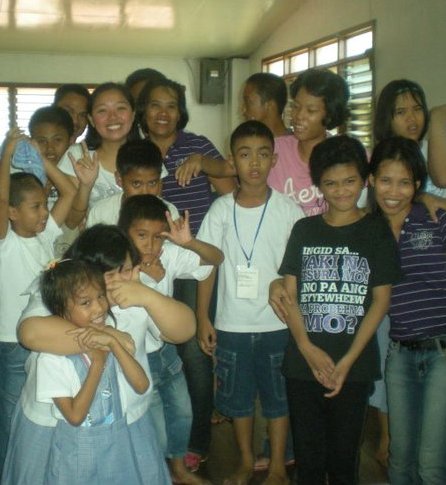
Children and staff with Joy Rile, MISYON editorial assistant
Joy, at the back left, and some of the boys, are making the ‘I love you’ sign used by the Deaf, a combination of the letters I, L and U in the Sign Language alphabet.
Father Mick is a Columban Missionary priest who spent more than 50 years in the Philippines and was assigned in different parishes. After finishing as parish priest of Dumalinao Father Mick thought of establishing a community-based rehabilitation program to help children with special needs. He invited me to join him and so in April 1998 we scouted in the different areas of San Jose Parish, Pagadian City, and found 47 children, most of them from poor families, with special needs. We invited their parents to a meeting where they expressed that they wanted to open a school for their special children. Since the program was to be community-based we hoped to train the parents and members of the families on how to help their children. It was really to be their program. We saw our role as motivating them and providing them with resources that they could not obtain themselves.
The program officially started on 3 August 1998. 24 children came to the center every morning. I was the teacher for the nine deaf children. Emma Andales and Helen Nelmida taught the other 15 students, those with learning disabilities, including Down Syndrome, and those with autism. Every afternoon the staff would visit the homes of children who could not come to the center because of their physical disabilities and encourage their families to support the program. The school catered for children with different disabilities except blindness. Lucy Endonto joined us in September that year as a volunteer.
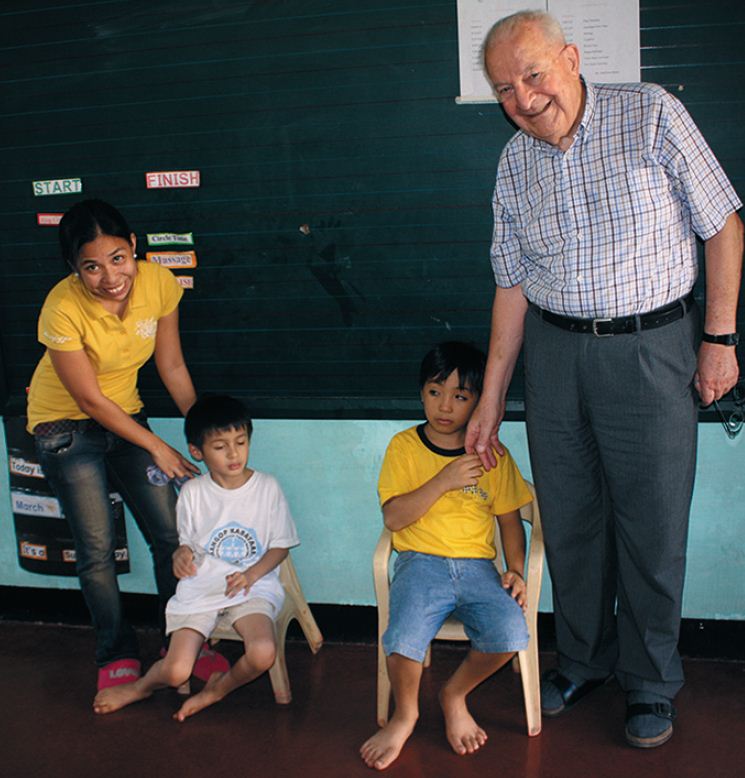
Fr Michael Sinnott with children in 2010
The program was initially offered in Barangay San Jose. Father Mick exerted much effort to make people aware, during Mass and wherever he went. Later, children from other barangays were also accepted. We refused no one. Everybody was welcome, as long as parents were willing to let them come to school. The school was named Hangop Kabataan, which literally means ‘to embrace children’.
Father Mick was very devoted to the children. He did his best to found the first school in the city for special children, and set up the Hangop Kabataan Foundation, Inc. He wanted to enable the children to be as independent as possible.
It was really difficult at the start. I was floundering since I knew nothing about classroom management or how to handle special children. But in God’s mercy, I learned along the way how to deal with each child. The teachers were sent for seminars and training. I attended a summer course in Basic Sign Language in 1998 at Welcome Home Foundation in Bacolod City, founded in 1988 by the late Columban Fr Joseph Coyle from Northern Ireland. It was very challenging as it was my first time to use my hands to talk with deaf people. But I wasn’t able to take the evaluation as I had to leave right away for another seminar in Ozamiz City related to the program.
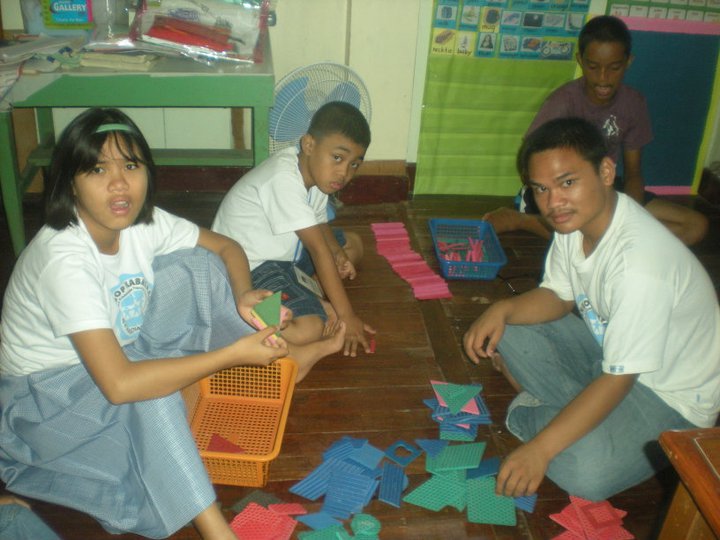
Students at Hangop Kabataan
Hangop Kabataan has three categories of services.
The first is for school-based children who are capable of attending classes at the center from Monday to Friday. We divide them into five groups, using color-coding according to their skills and needs. The Blue Class is composed of children with autism who cannot sit still during class and so need the full support of a teacher. The Yellow Class is composed of children with autism but who can follow some verbal instructions, do simple writing as well as art works and have developing motor skills. The Pink Class is for children with different types of disabilities but who are focused and able to write their names and copy words. We are preparing them to cope with mainstreaming in a regular school. The Green Class is also of children with mixed disabilities who are trained to cook our daily snacks for the children of Hangop. The Violet Class learn some functional academic subjects such as Simple Mathematics and Values Education. They are also trained in skills such as planting and caring for flowers and trees as their livelihood projects.
St Valentine’s Day celebration, 14 February 2011
The second category is for home-based children who cannot come to the center due to the severity of their disabilities. Two staff are assigned to do home visitation every afternoon to conduct some exercises, tutorials and to encourage the family to continue nurturing their children as much as they can.
The third category is the Deaf Club, composed of adults who want to look for a job so they can help their families even in a little way. Five years ago three members of the Deaf Club were employed by the City Government as casual workers and one got work in a fast food chain in the city. The Deaf Club meets at the center every second Saturday of the month for some inputs, workshops and socializing to help them become more rounded persons and to be involved in the wider society as responsible citizens.
Hangop Kabataan children at interfaith rally in Pagadian City when Fr Sinnott was kidnapped in 2009
I really love my work. It’s easier for me now. The children are very loving. Compared to high school students, they are light-hearted. They don’t hold grudges. It is a big consolation for us to see even a small improvement in a child. It’s a joy to know that they are able to read compared to when were enrolled in normal schools where they didn’t receive much attention due to the large number of students.
The most challenging thing for me is to see the children being degraded by others, with some calling them ‘abnormal’ or ‘crazy’, saying ‘hayop’ (‘animal’) instead of ‘Hangop’. That really hurts me and there were times I picked a fight defending our children. We are challenged to teach them to upgrade their status and be treated equally with others in the community.
Hangop Kabataan children at the interfaith rally for Fr Sinnott
There were instances when Father Mick would hear individuals disrespect the children. He would get angry and tell them, ‘Tarunga imong gikasulti’ (‘Watch what you’re saying!’). He was very loving to the children and so much like a grandfather to them. And I can still hear him say, ‘Tanang mga bata moanhi sa center batuna jud. Bahala na ang ginikanan basta kay mga bata ang may kinahanglan. (‘Welcome all children who come to the center. Never mind the parents since the children are the ones in need’). And if parents weren’t supportive he would tell us to continue to encourage them as that was still part of our responsibility.
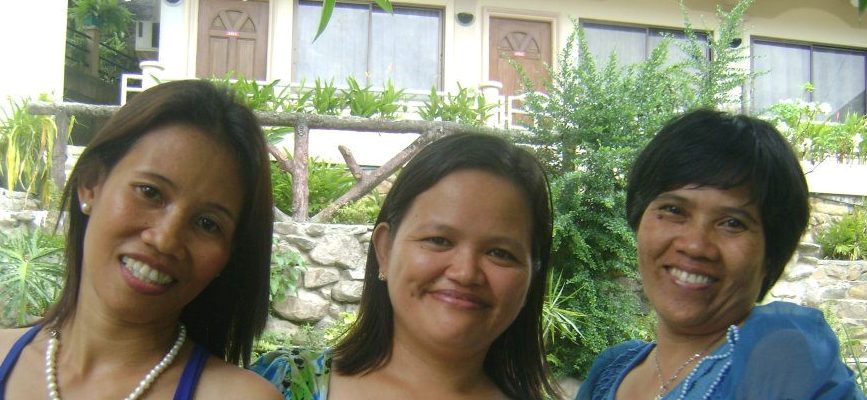
Staff members Lucy, Emma and Jojo
When Father Mick left us with the new administration, it was really a challenge. We were so used to having him around. But by God’s grace, we have made it up to the present. At times I say, ‘Lord, oi, I’m tired already. Is this where I’m supposed to grow old?’ There are days when I feel exhausted but next day I’m alert again! When I look at the children my heart picks up again. Now I am more used to the work, with a more relaxed mind. Fr Mick was also a big help to my spiritual growth and needs. Even though he has left us we sometimes contact him through email if we have problems.
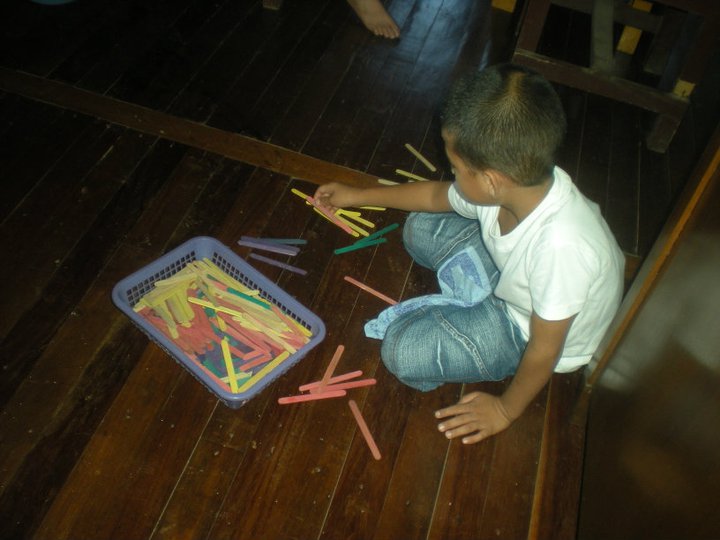
One of the youngest students at Hangop Kabataan
Father Mick urged me, ‘Padayon sa pagtukod sa gingharian sa Ginoo (‘Continue to build the kingdom of God’). His favorite line from the Bible still keeps me going. I will always hold it in my heart.
I would like to express my deepest thanks to Fr Mick because he trusted me as one of his workers in this amazing program. I consider him my second father in my life and I knew that he has been an instrument of God in making me a better person. Thank you very much, Father Mick. I will never forget you. God bless us all!
Father Sinnott was kidnapped in Pagadian City in October 2009 but released, unharmed, a month later. Shortly after that he moved to Manila and later retired in Ireland. He is in good health and turned 87 in December 2016.
‘Thank you’ message from Fr Michael Sinnott after his release
My Indian Fathers in Fiji
By Fr Kurt Zion Pala
Father Kurt was ordained in his native Iligan City, Mindanao on 21 November 2015. After his ordination he spent some months in Our Lady of Remedies Parish, Malate, Manila, before moving to the Columban house in Cagayan de Oro City where he has been involved in vocation work, mission promotion and fundraising. He will be leaving for his new assignment in Myanmar early this year.
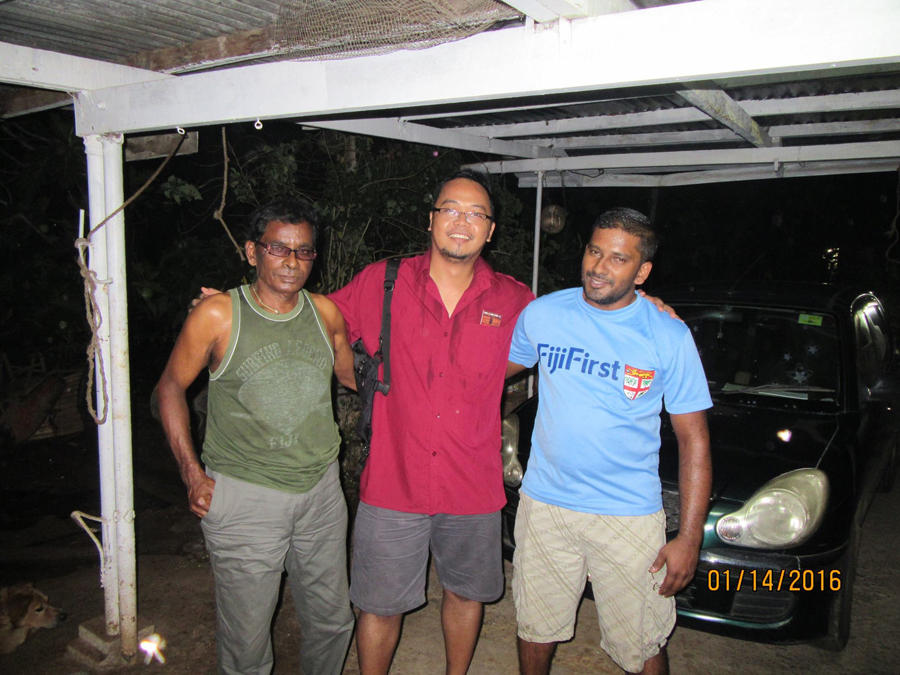
Father Kurt, center, with Abba Sam Daniel and Reverend Roneel Avinay
‘“Abba”, call me that,’ my host father responded when I asked him how I should call him. ‘Abba’ is the Hindi (Indian) word for ‘father’. Sam Daniel would be my third host-father in Fiji. He is Anglican and lives with his wife near their church. They have a son, Roneel, who is now an Anglican priest. Abba works as the school manager of the Anglican Church-run schools in Labasa. He would wake up to feed the chickens. After breakfast he would drive me to the Catholic church for my Hindi lessons and he would report to school. In the afternoon, we would then meet at a small shop near the school and have small talk with his friends. In the evening some of the neighbors would come over and we would have a game of cards and enjoy a big bowl of kava.
A card game in Abba Sam Daniel’s home
I attended Anglican services together with the family. What I enjoyed most was the singing of hymns at the beginning of the liturgy. I would sit with the musicians and sing my heart out. Abba loves his Indian TV drama series. We would watch these together series in the evening just before going to bed. I lived with Abba’s family for almost a month before moving to the parish.
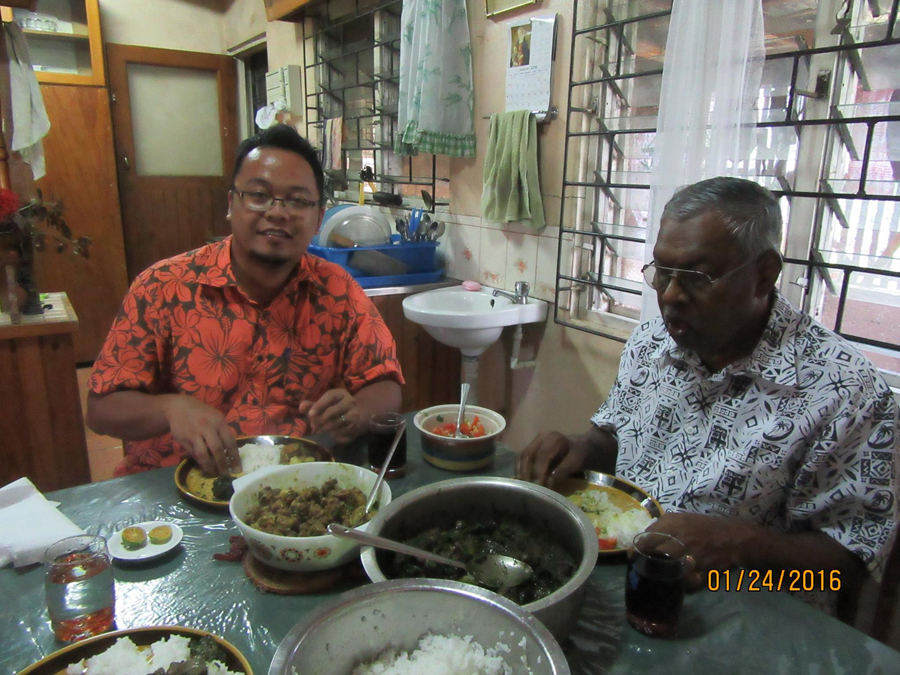
Enjoying lunch with Uncle Bale
Homestay is an important component of being a student missionary. The best way to learn the language and culture of the country we are sent to is to live with a family from as short as a week to as long as six months. Like Indians, Filipinos never call their elders by their first names. So the first thing I did is to familiarize my relationship to people around me as they are related to me being the ‘son’ of the family I am living with. For most of my two years in Fiji I lived with three families at different stages of my assignment.
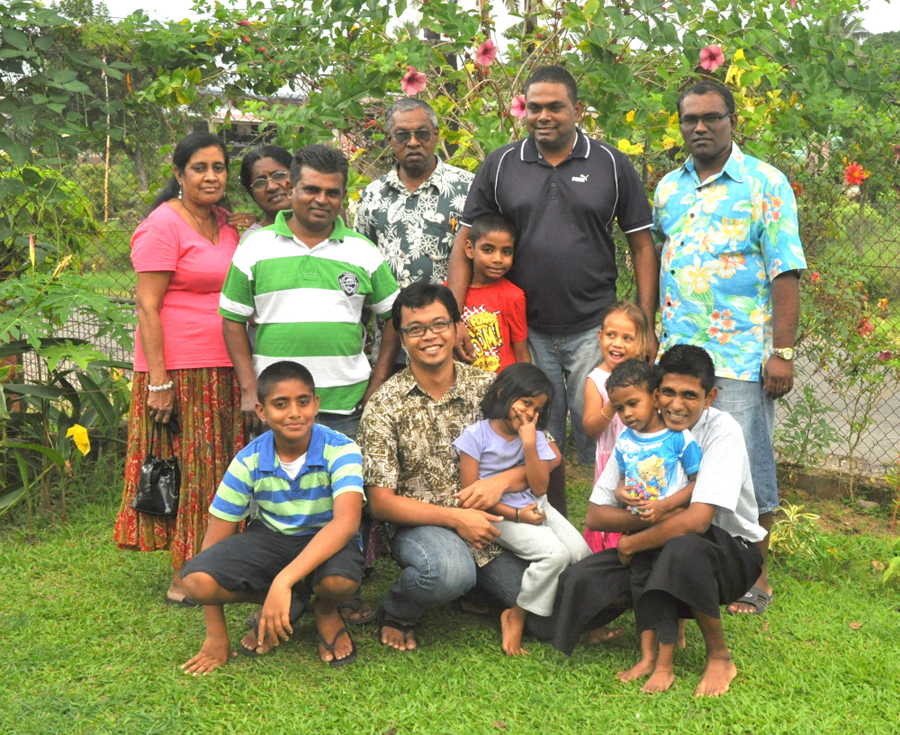
With members of Nadera Mandali
The first family I lived with, during my first six months in Fiji, was that of Ignatius Balkisun (Bale) and Pauline Rosy. They have two daughters, Bernie, a dentist and Pat, a teacher. Pat and her husband live with the couple while Bernie lived on her own in Suva. Most of the day I was alone with Uncle Bale and Auntie Pauline. The family belongs to the Nadera Mandali group, a form of Basic Christian Community. Families take turns hosting the Friday prayer meetings. I would accompany the couple to these prayer meetings and to Sunday Mass.
Auntie Mary and Uncle Bhola
After six months of urban exposure in Suva, the Fijian capital, I moved to the northern island of Vanua Levu. For my rural exposure, I lived with the Reddy family in the hills of Naleba, Labasa. Sanmogan, and Mary Reddy (Uncle Bhola and Auntie Mary) have three children, all teachers now. I stayed with them for almost all of my six months on the island. I was introduced as a son of the family and so in the village, I related to everyone either as their nephew, grandchild or uncle. And I had to learn every name to call them ‘Ajja’, ‘Ajji’ (Grandfather, Grandmother), ‘Mama’, ‘Mami’ (Uncle, Aunt) and so on. We did many things together. Sanmogan introduced me to many of his friends, not only Catholics but Hindu and Muslim neighbors. I had a most interesting time in Naleba. During my last few days there I noticed he was very quiet and seldom spoke to me. As I was about to leave he embraced me tightly and sobbed. It felt great to be considered a son.
Uncle Bhola
These were my Indian fathers - Uncle Bale, Uncle Bhola and Abba. They were not perfect but they were faithful fathers. They were hardworking but knew how to enjoy life and share their blessings with others. Just like my father, they were not very expressive of their feelings, especially of affection, and showed everyone they were independent and strong. But I felt privileged to indulge myself with their love. And they reminded me of my own father who taught me to pursue in life what makes me happy and to never stop following my dream.
Salamat, Tay! Thank you, Uncle Bale, Uncle Bhola and Abba.
Fr Jung Euikyun Carlo and Fr Kurt Zion Pala in Fiji as seminarians
Father Carlo was ordained in Seoul on 1 November 2014 and Father Kurt in Iligan City on 21 November 2015
Persons to watch for in the video.
The video was shot in Naleba, in Paharkhala where Father Kurt lived, and in Karokaro where Father Carlo lived with another family.
2:58-3:07 Kurt met by Uncle Bhola
4:01-4:36 Playing cards with Uncle Bhola and featuring Auntie Mary.
11:30 – 11:51 Drinking kava / yaqona with Uncle Bhola. [Yaqona is pronounced ‘yangGOna’]
The Joy of Encountering God’s Presence in the Andes
By Erl Dylan J. Tabaco
The author is a Columban seminarian who spent two years, 2014 – 2016, in Peru on his First Mission Assignment (FMA), part of his preparation to be a Columban missionary priest. He is from Holy Rosary Parish, Agusan, Cagayan de Oro City. He is a regular contributor to MISYONonline.com.
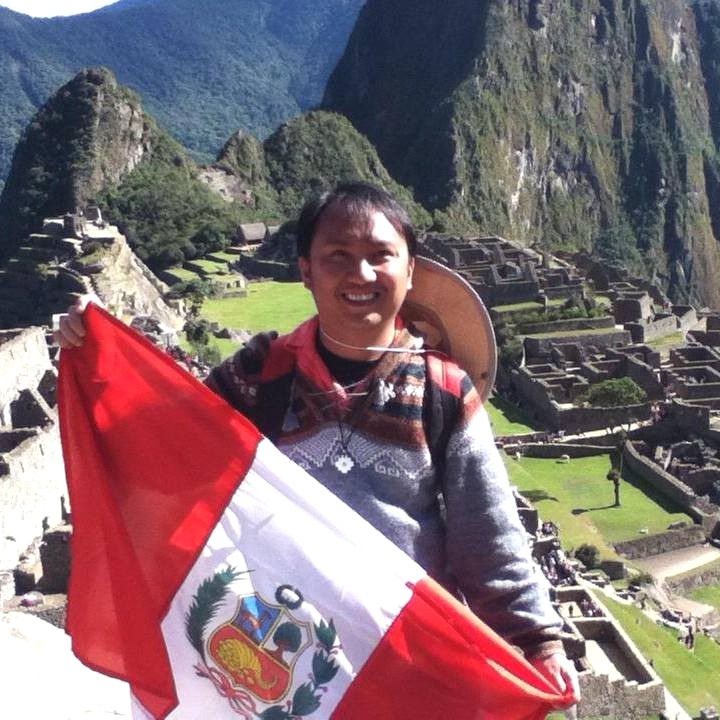
Erl with the Peruvian flag at Machu Picchu
Since childhood I have been fascinated by geography. As a child I loved to build ‘islands’ and ‘mountains’ of sand on the seashore and imagine myself at their summits. It was a lifelong dream to travel but being in Peru was far beyond my imagination.
I spent the first of my two years on First Mission Assignment (FMA) in Lima where I got used to the busy and sophisticated life of the metropolis. I wondered what other parts of Peru were like. Its land area is four times that of the Philippines and is divided into three major parts: costa (coastal area), sierra (Andes Mountains) and the selva (Amazon area). My sense of awe at this beautiful country brought me to an experience that would have a significant impact during my first missionary journey.
In August 2015, Emmanuel Trocino, my FMA companion from Pulupandan, Negros Occidental, and I travelled from Lima to Cusco for a week-long exposure in the high plain region of southern Peru. I was very excited since Cusco is the birthplace of the Inca civilization and the location of one of the ‘New7SevenWonders of the World’, Macchu Pichu.
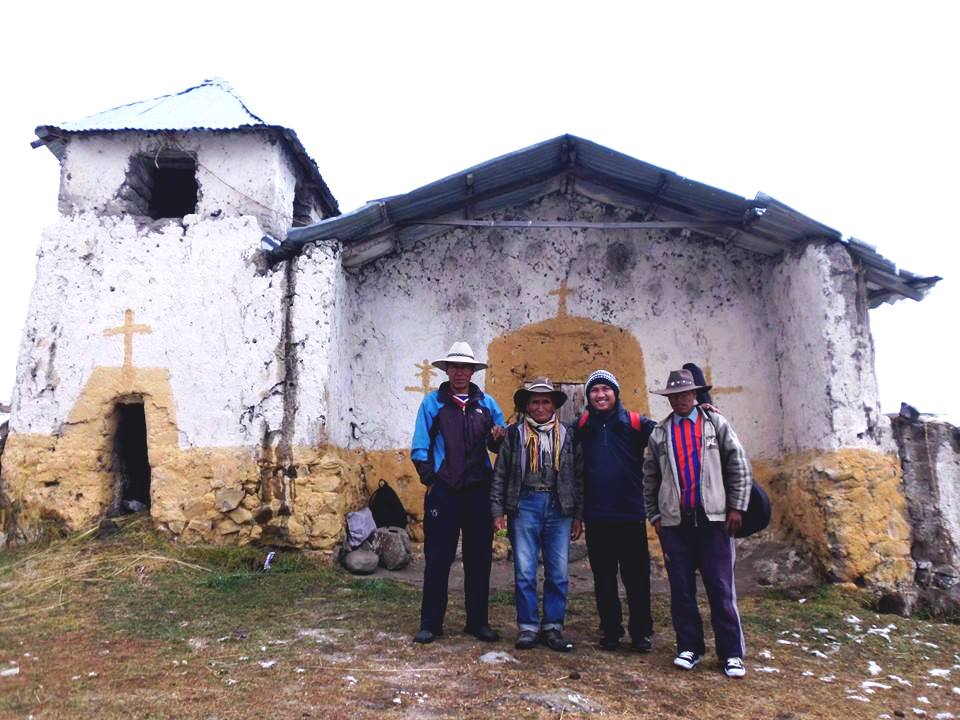
Erl (3rd from left) outside the chapel in Machucayo A
When we arrived in the city of Cusco, the capital of the Cusco Region and former capital of the Inca Empire, which is twice as big as the island of Negros, I felt faint, not surprisingly since we were at an elevation of 3,399 meters, a thousand meters higher than the summit of Mount Apo, the highest mountain in the Philippines. We were accompanied by Fr Gregorio Kim Young-In, a Korean Columban based in the Parish of St James the Apostle of Yanaoca in the Prelature of Sicuani. We spent the night in Cusco city to acclimatize ourselves to the altitude, since Yanaoca, where we were heading, is even higher, around 4,000 meters. It was a night filled with awe and wonder as we prepared ourselves physically for the continuation of the journey.

Fr Gregorio Kim Young-in, Fr Paul Prendergast and Erl (4th from right) with catechists in Fr Paul’ house
Early next day we continued our journey and after two and a half hours of driving we arrived at the parish. The Parish Priest, Fr Paul Prendergast, a Columban from New Zealand, welcomed us on behalf of the community with their traditional tea made of cocoa leaves that is helpful in alleviating altitude sickness. The serenity of the place and the simplicity of the people amazed me. It was very cold and the freezing air penetrated my bones. Nevertheless I was mesmerized by the beauty of God’s creation. It was my first time to see snow. This thrill took away my dizziness. I started roaming around the place feeling excited not knowing what new experiences I would encounter. I struggled to understand the local people since the majority spoke only Quechua, their native tongue, rather than Spanish.
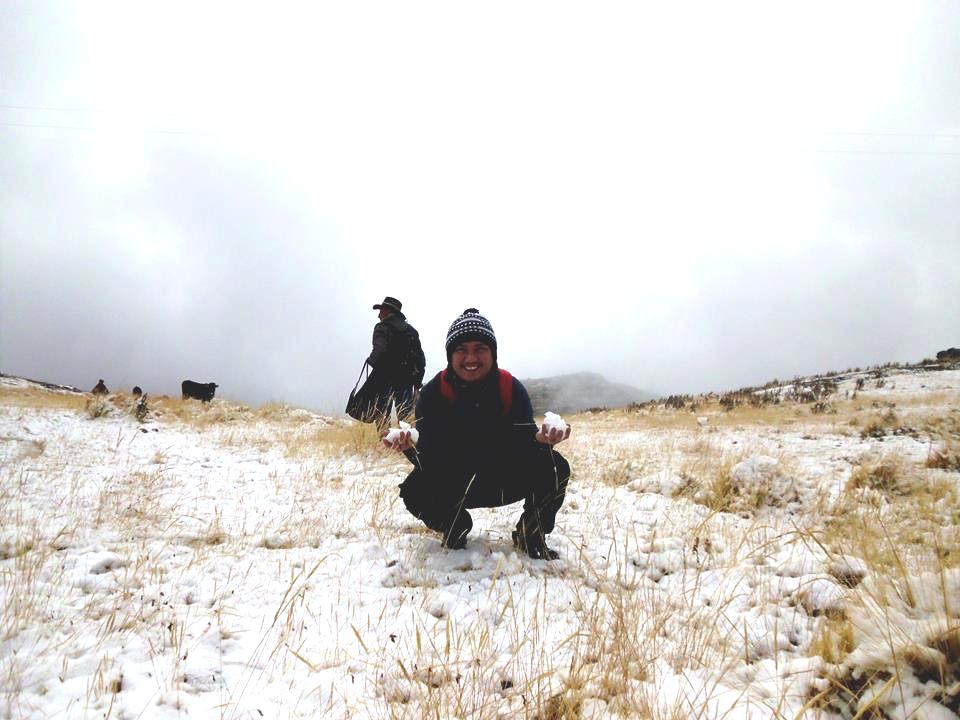
First experience of snow!
The presence of the Columbans has been a great help in the Prelature of Sicuani. Aside from the main parish church, there are several chapels and distant communities where Fathers Paul and Gregorio administer the sacraments. As in the Philippines, Mass is celebrated in their chapel on the fiesta of a community’s patron saint.
We visited Machucayo A, a community 90 kilometers away from the main church. On the way, Father Paul told me that during his early years there he usually walked or rode a horse to reach far-flung areas. He has spent most of his life in this area, building friendships with people. This and bringing God’s love are, for him as a missionary, inseparable.
We can only be effective in our ministry if we value the dignity of every person we encounter. He is now almost 80 and his passion for his ministry continues to inspire me. His love and care for the people are the reasons he looks forward to every single moment with them.
After we arrived at the chapel people slowly began to come. One woman carrying a basket full of fruit and vegetables told me that she and her companions had walked for almost five hours to attend the Holy Mass on the feast of Blessed Virgin Mary. The chapel looked like a shack. It was very old and empty except for the little altar. As we began Mass the community sang wholeheartedly. I was amazed at their participation. I didn’t understand a word since the Mass was in Quechua. The people’s gestures showed their reverence. My experience of the Holy Mass in that community was totally different from that anywhere else. I felt the importance of the Mass in the lives of everyone present. They offered everything to God: their time, presence, family and the work of their hands.
Reflecting on my experience, I had a glimpse of what the heavenly banquet looks like. I was moved to tears and it was a life-changing experience for me. I’ve come to realize that sometimes people with ample time and opportunity to attend Mass often fail to do so, while those with hardly any time cherish every moment of it. Those who had walked for five or six hours were mostly mothers who wanted to thank the Lord through the celebration of the Eucharist. At that time I believed in my heart that God had revealed Himself to me through the faith of those people, a faith that touched me deeply.
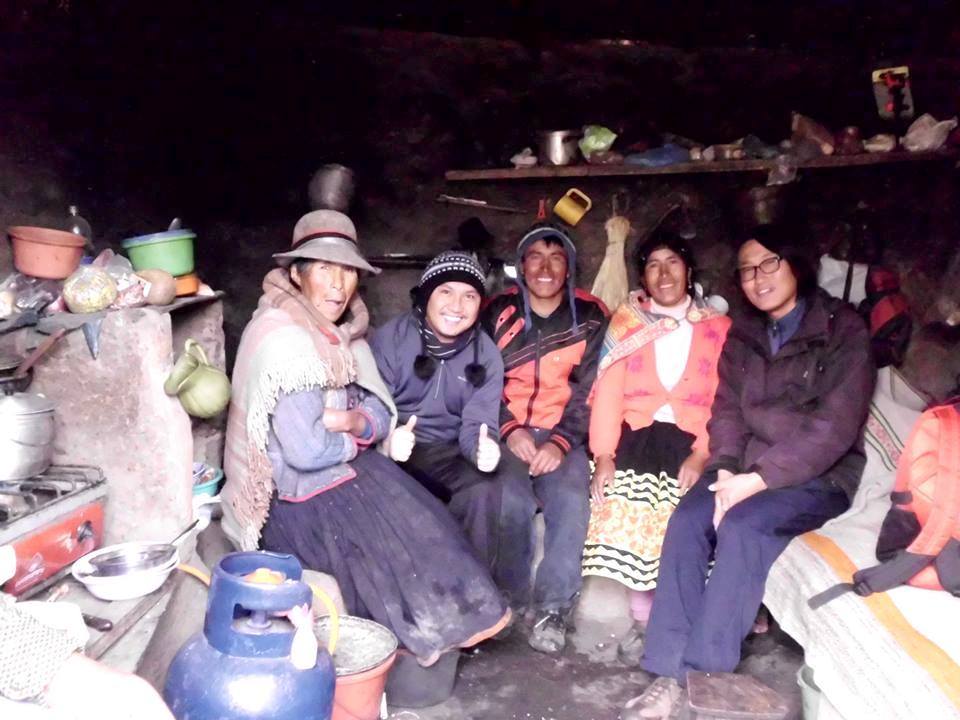
Erl (2nd from left) with Fr Gregorio (far right) in the house of a catechist
After Mass we were invited by the head catechist to lunch in his very small house where he lived with his ailing mother. He prepared a delicious meal, a traditional Andean delicacy. As his mother served us, she said quietly, ‘La casa es chiquita pero el corazon es grande’ – ‘The house is small but the heart is big’. Reflecting on those words I’ve learned that encountering the presence of God doesn’t have to be extraordinary or mystical. Even in the most ordinary situations we will encounter Him as long as our hearts are open to that.
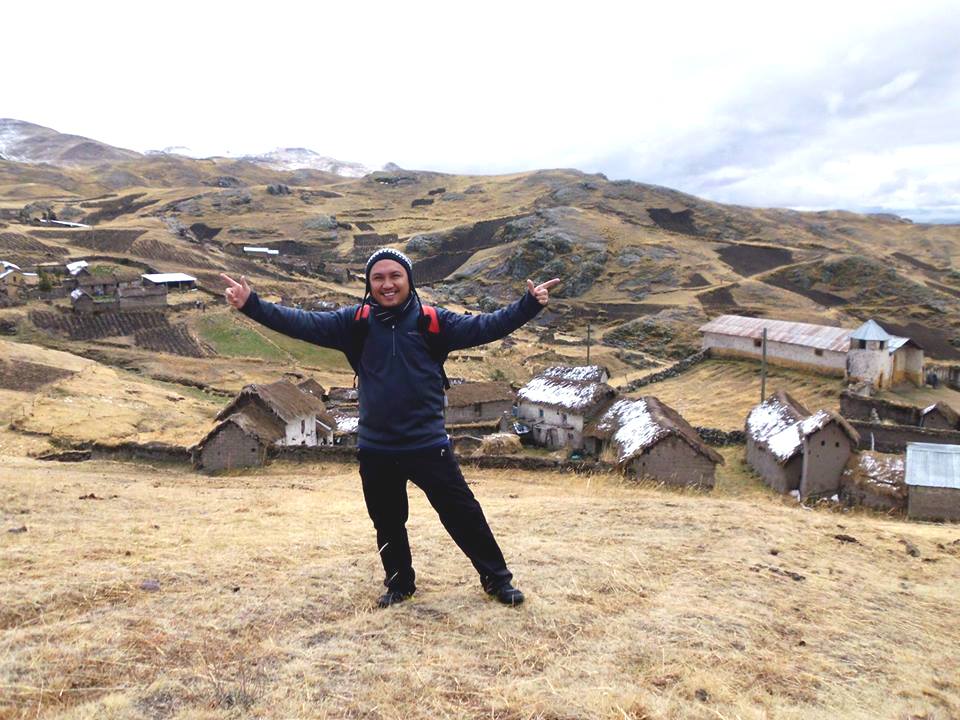
Erl ‘On Top of the World’!
The beauty of the place and the goodness of the people of Machucayo A prepared me for that unforgettable encounter with the God who is always by the side of the lowly. Those people may lack material things but their faith in a loving God, expressed in their daily lives, is very rich. In their simple lives God is manifested. As I bade farewell to them I was reminded of a beautiful song during our mission sending: ‘I’ll shout it from the mountain top, I want the world to know. The Lord of love has come to me; I want to pass it on.’ As I continue my journey to the Columban missionary priesthood, I want to retell the story of how I encountered God in Machacuyo A in the Andes.
‘I want to pass it on’
‘Why me? Why me?’
By Anne B. Gubuan
This is the vocation story of Fr Finbar Maxwell from Ballyfermot, Dublin, Ireland, who was ordained as a Columban priest in 1988. The author is Assistant Editor of MISYONonline.com.
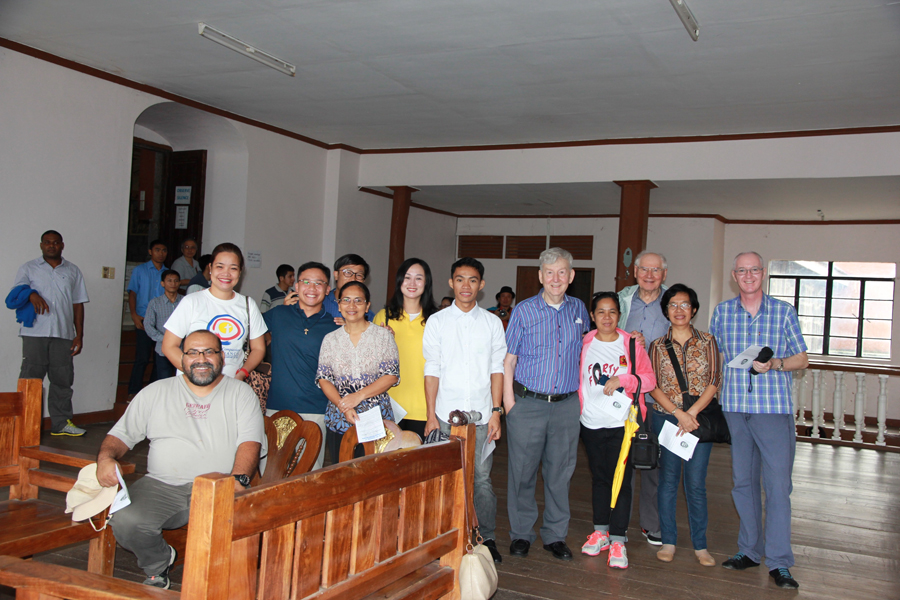
Anne, far left, Father Finbar, far right, Pililla, Rizal, 28 September 2016
I am always spellbound listening to vocation stories. They are almost always stories of faith and courage, the pain of letting go and braving the oceans of a missionary journey. What makes these stories extra fascinating for me is the fact that these missionaries leave their families without the promise of going back to be with them again. I don’t think I have or will ever have that kind of courage.
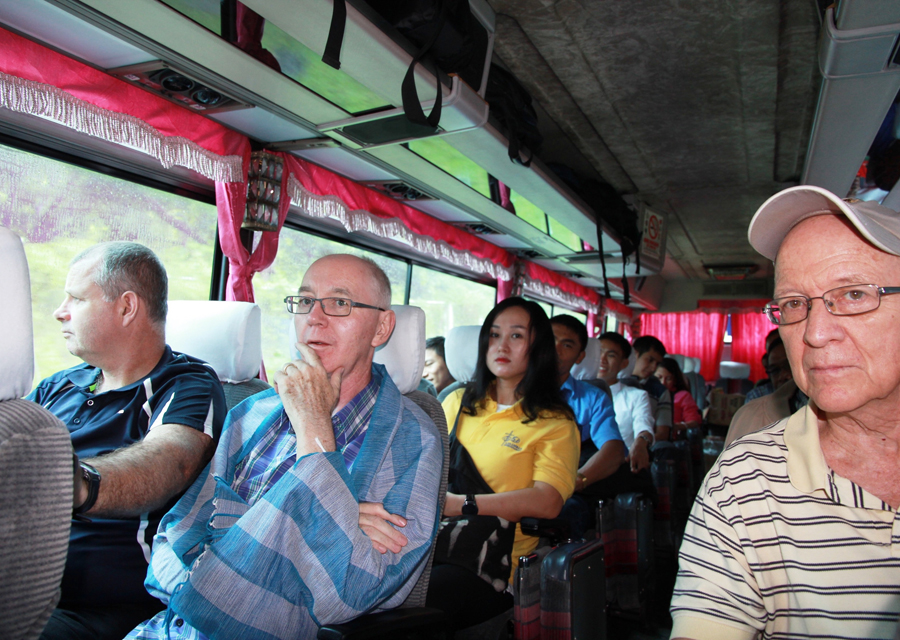
Pilgrims L to R: Fr Paul Glynn, Regional Director since 23 November, 2016, Fr Finbar Maxwell, Noh Hye-in Anna, Fr Vincent Busch
Frs Paul and Finbar are Irish, Fr Vincent American and Anna, a Columban Lay Missionary, Korean.
I had the privilege of listening to Fr Finbar Maxwell’s vocation story on the bus during our pilgrimage to Paete and Pililla last September. Father Finbar had spent 20 years as Columban missionary priest in Pakistan, and four years ago he was sent to the Philippines and is currently Vice-Rector at the Columban House of Studies in Cubao, Quezon City.
As a teenager in his native Dublin, Ireland, he was deeply involved in his home parish, especially the social services in their community, including care for the elderly, to whom he was particularly dedicated. Every day he would stop and visit them. With other young people he would make himself available for activities like decorating their church for Sunday Mass.
During his involvement in the parish he was inspired and encouraged by Fr Arthur O'Neill, the priest coordinating church events and activities. Over time he began to think ‘I’d like to do that – live my life as a priest’.
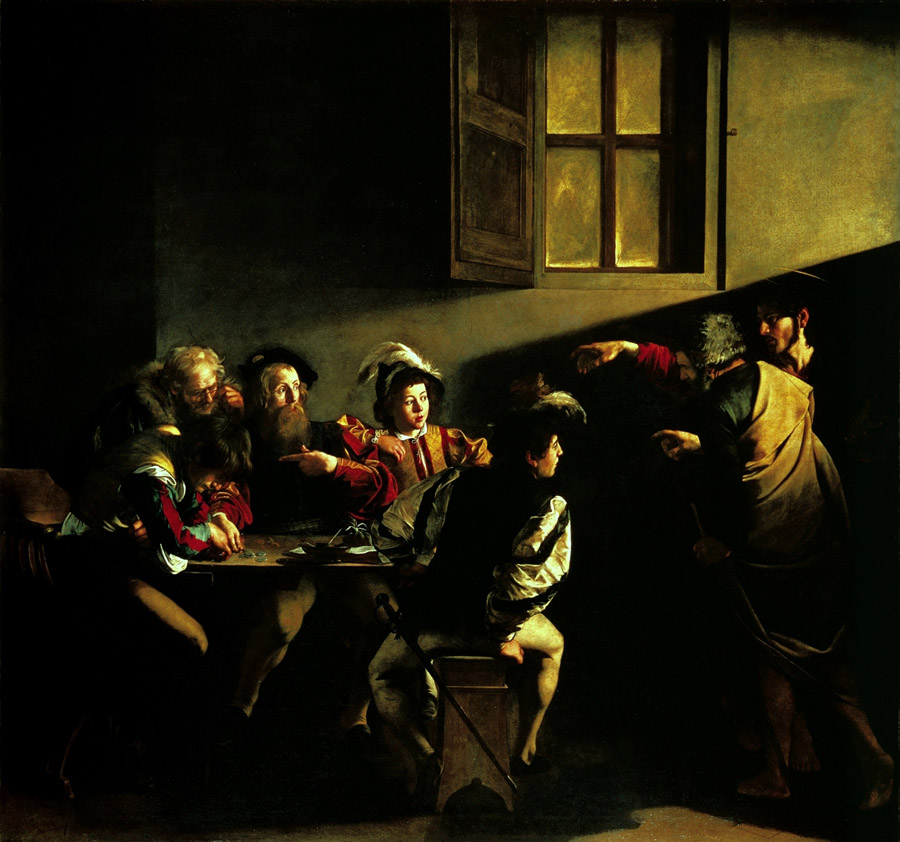
The Calling of St Matthew, Caravaggio [Wikipedia]
As Jesus passed on from there, he saw a man named Matthew sitting at the customs post. He said to him, “Follow me.” And he got up and followed him. (Matthew 9:9)
Father Finbar sometimes uses this painting in giving retreats.
He told his parents that he would like to go for the come-and-see weekend at St Columban’s, Dalgan Park, where young men interested in knowing the Columbans are invited and given an orientation and overview about Columban life and mission. His parents were a bit surprised, but supportive. ‘The week I entered the Columbans I told my brothers. One younger brother responded, surprised, “What – you?”’ His brothers, though, were also supportive. His parents however, did say, ‘If it’s not for you, always feel free to return home.’
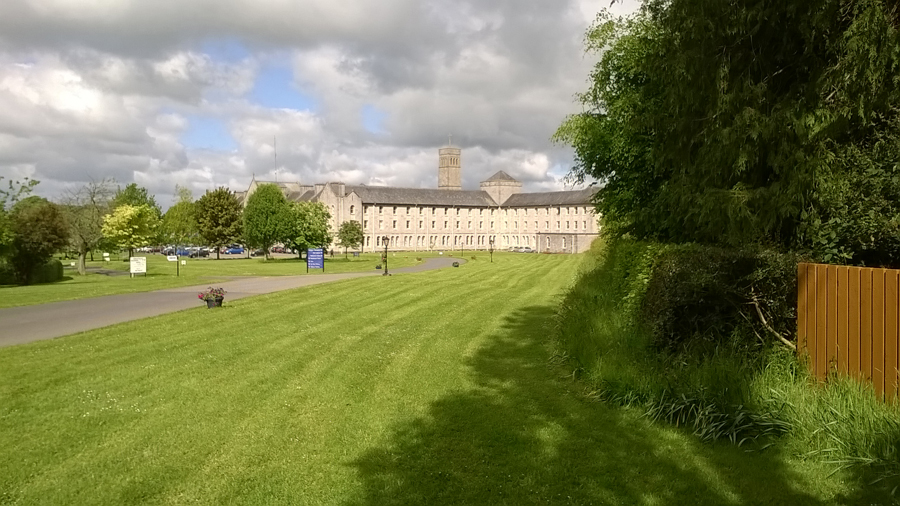
St Columban’s, Dalgan Park, Navan, Ireland
Smiling, Father Finbar recounted his earlier days as it grew into his Columban vocation. Though there was much that was new to him, the Columban way of life opened up to him. From his first come-and-see weekend, he was fully aware that Columbans were missionaries and that they would be sent on mission overseas. A point came at an early stage in his formation journey when that reality came to him at a deeper, emotional level, and that eventually leaving his home country would be a leap he would have to make. Initially, a difficult part of that ‘leap’ would be leaving his family, and leaving all that was familiar. He wrestled with this for a year during his early formation, and talked about it openly during spiritual direction. The Lord, however, provided him with an experience that was to bring great clarity and freedom to him, in making this leap into an ‘overseas’ life as a Columban on mission.
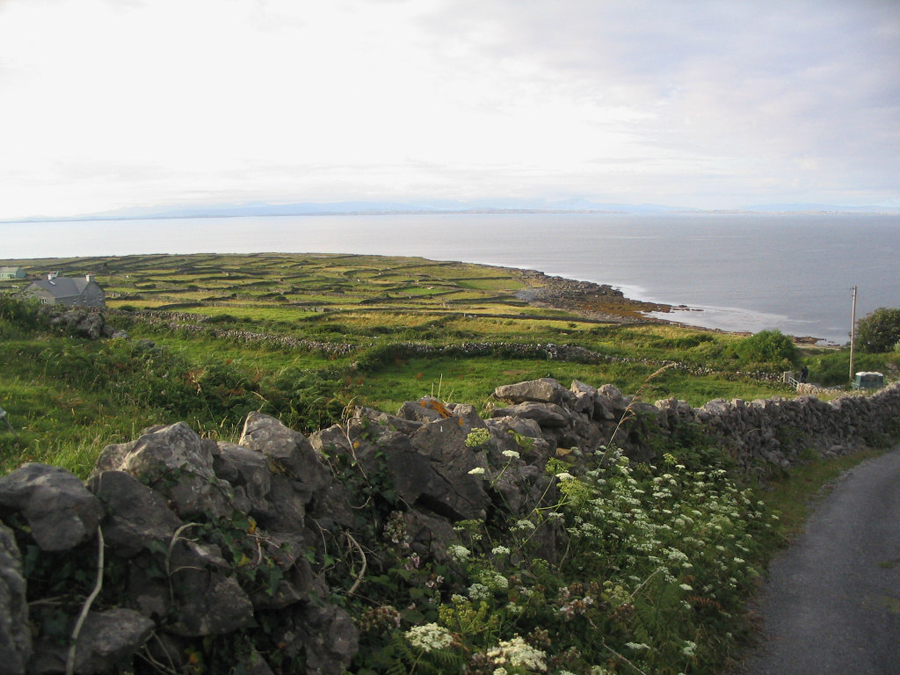
Inis Mór, the largest of the Aran Islands [Wikipedia]
He recalled: I think it was for me a ‘why me’ moment. I kept asking God, ‘Why me? Why me? How can I be sure, why me?’ During my summer vacation I went for a week to the Aran Islands. It’s a very beautiful but lonely spot off the west coast of Ireland. I went for a holiday by myself and also to give myself time to think. One evening at about 6 o’clock, I read a story in the book ‘As Bread That Is Broken’ by Peter Van Breemen. It was a beautiful summer evening and I was sitting on a rock, overlooking the Atlantic.
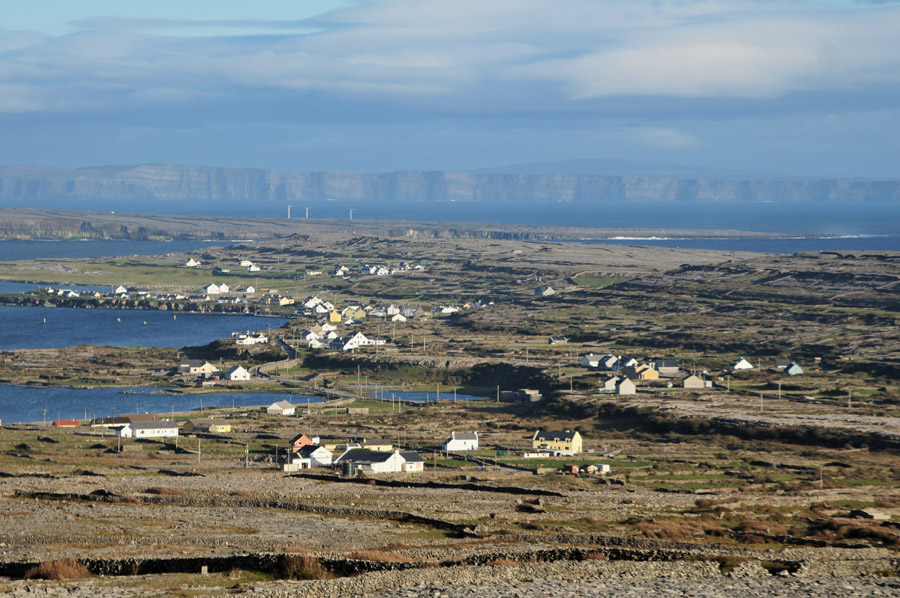
View over Inis Mór, looking towards the Cliffs of Moher on the mainland [Wikipedia]
The story was about a young man who was asked by the king to go to a faraway place to deliver a message. He was told by the king that he would meet difficulties on the way, but that he was to give the message to the faraway kingdom and then, on his return, report back to the king. On the way the young man met many trials, and he kept saying, ‘Why me? Why did the king choose me to deliver this message?’ That’s what resonated with me in the story. I felt the young man was asking my question. There I was, sitting on this rock, overlooking the ocean, with the evening sun in the sky; I was reading this book and suddenly thought, ‘Oh my gosh!’ At the end of the story the young man reports back to the king. And the king asked, ‘Did anything happen to you on the way?’ and he said, ‘Well, I delivered the message but these doubts and questions arose, “Why me, why me?”’ and the king said, ‘Why not you? I could have chosen anyone but I chose you’.
At that moment I felt a real sense of illumination. Something hit me, and I felt like scales had fallen from my eyes. That moment I closed the book, went back to the guest house where I was staying, packed my bag, and the next day I left the island. A couple of weeks later I returned to a new academic year in our Columban formation house. And many years later, here I am now.
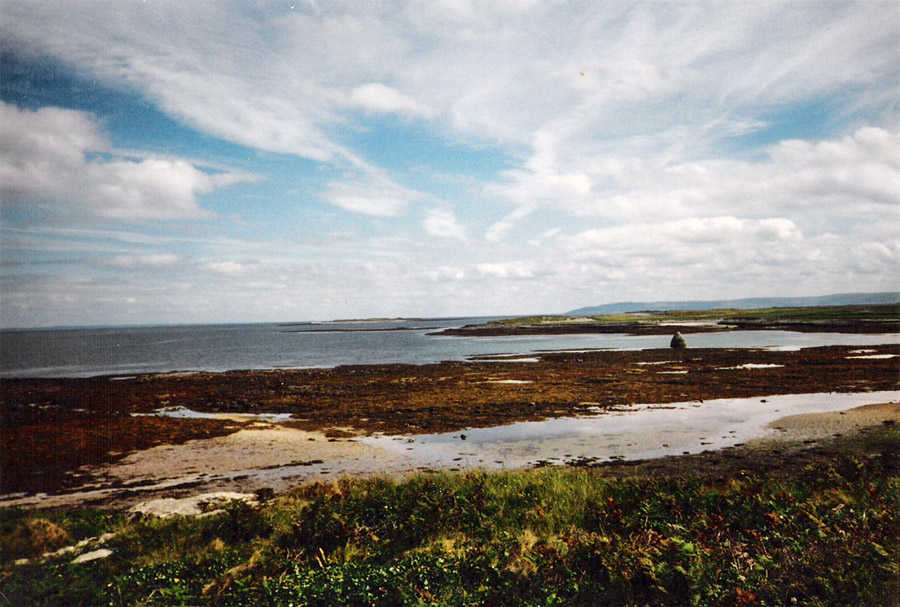
East Beach, Inis Mór [Wikipedia]
Finishing Father Finbar’s vocation story, I can’t help but look back and think about my almost two decades working for MISYONonline.com. Those two decades have allowed me to meet and encounter the Columban Fathers, become friends with them, become part of their family. Like many of them that I have gotten to know, Father Finbar radiates this kind of joy of being a missionary priest who has given up so much to follow where Jesus has called him to be.
About three weeks before I wrote this, my son Gabriel and I attended a beginning-of-the year retreat. Before that three-day retreat we had our penitential rite and that’s when my son expressed to me, ‘I think I would want to become a priest’. It was way too surreal for me to take seriously, but that particular afternoon at the retreat, during the call for vocations my son stood up. My mind swirled a bit as I received congratulations from our church companions, some of them grinning, most of them teary-eyed. My son is only 11. Nothing is too certain yet. But Father Finbar started thinking about it when he was an active youth member in his parish. I think I, too, would want my son to have his own ‘Why Me?’ moments in the near future.
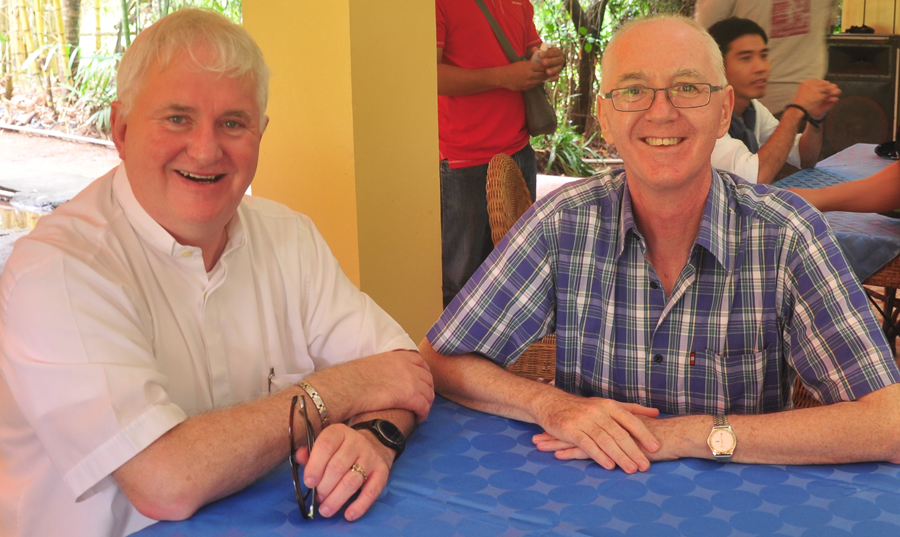
Fr Raymond Husband, Rector, and Fr Finbar Maxwell, Vice-Rector, Columban House of Studies
To Search is To Find
I am amazed at how some people can very well testify about their personal encounter with God, how vivid their experience of God manifesting Himself. I am happy for them but at the same time I envy them. In my lifetime I can’t remember a moment of a close encounter with God. Why can’t I feel Him? Is there something wrong with me? What must I do?

Dublin buses [Wikipedia]
In 2013 years I was traveling on a bus in my native Dublin, Ireland. There was a girl of about 16 or 17, accompanied by a little boy of about three, standing near the driver. She kept talking into her cell-phone and seemed agitated. Finally she asked passengers near her, ‘Have we come to Blanchardstown Centre yet?’ I was astonished as I had boarded the bus after it had come from there. I knew by the girl’s accent that she was from Dublin. She was lost in her own city. I figured that the boy was her brother, but possibly her son.
Immediately the passengers near her, mostly older women, and I responded and made suggestions as to how she could get to the Centre. The driver, who overheard all this, took over and said that when the bus arrived at the terminal he would put them on the first bus going to the Centre.
That was but one of many occasions when I have encountered Jesus on the bus.
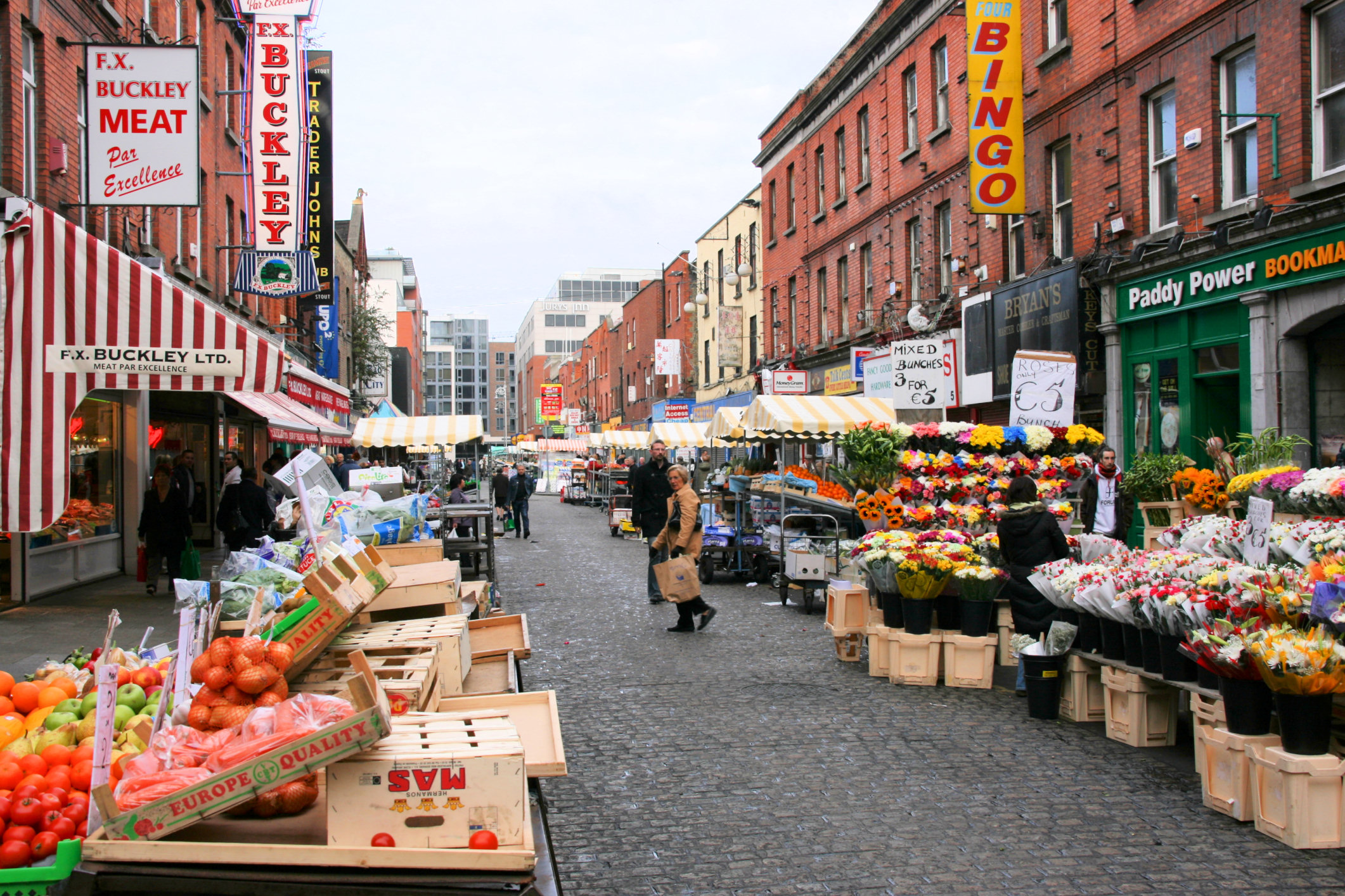
Moore Street, Dublin [Wikipedia]
When I was a young priest, before I came to the Philippines, a shabbily-dressed old woman stopped me in a poor part of Dublin. I thought she was going to ask for money but she simply wanted to share how lonely she was. She kept repeating this.
That was but one of many occasions when I have encountered Jesus on the street.
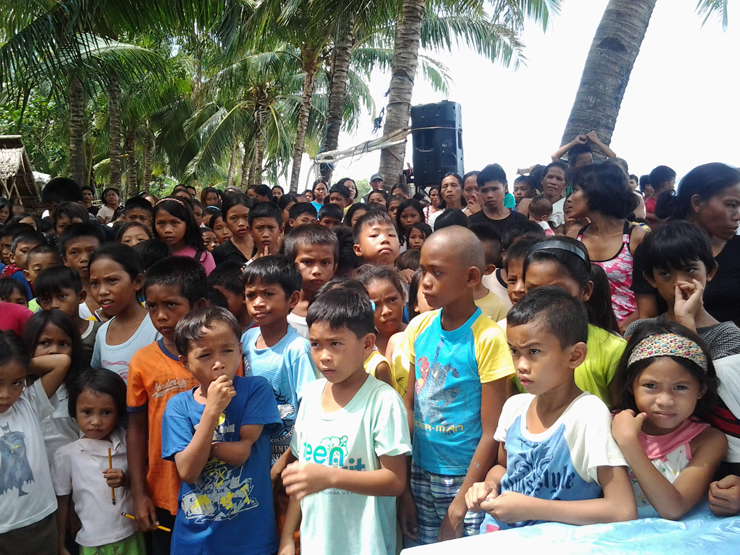
Children of Hinoba-an, Negros Occidental
Here in the Philippines, on the first occasion I visited a home for girls, most of whom had suffered traumatic experiences, one of them, aged 12, approached me before the program after Mass and dinner and said in utter trust, ‘Father, you won’t laugh at me, will you?’ When she sang, it was with a truly angelic voice.
That was but one of many occasions when I have encountered Jesus in children.
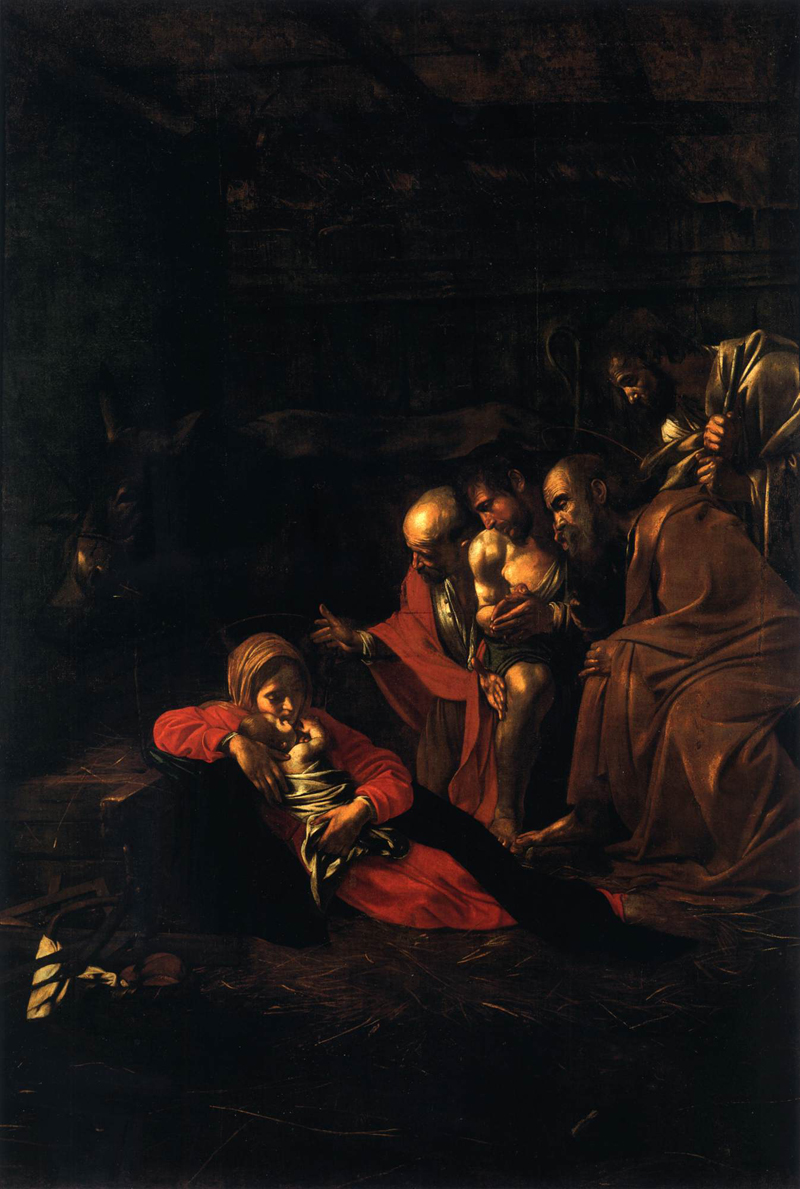
Adoration of the Shepherds, Caravaggio [Web Gallery of Art]
I think that the homily of Pope Francis in St Peter’s on Christmas Night, 24 December 2016 is perhaps related to your query. Here is the last part.
That night, the shepherds understood this. They were among the marginalized of those times. Yet no one is marginalized in the sight of God, and that Christmas, they themselves were the guests. People who felt sure of themselves, self-sufficient, were at home with their possessions. It was the shepherds who ‘set out with haste’ (cf. Lk 2:16). Tonight, may we too be challenged and called by Jesus. Let us approach him with trust, starting from all those things that make us feel marginalized, from our limitations and our sins. Let us be touched by the tenderness that saves. Let us draw close to God who draws close to us. Let us pause to gaze upon the crib, and relive in our imagination the birth of Jesus: light and peace, dire poverty and rejection. With the shepherds, let us enter into the real Christmas, bringing to Jesus all that we are, our alienation, our unhealed wounds, our sins. Then, in Jesus, we will enjoy the taste of the true spirit of Christmas: the beauty of being loved by God. With Mary and Joseph, let us pause before the manger, before Jesus who is born as bread for my life. Contemplating his humble and infinite love, let us simply tell him: Thank you. Thank you because you have done all this for me. [Emphasis added]
Caravaggio catches the utter trust of Mary in the shepherds – like the trust the young girl in the home showed to me – and, indeed, the closing words of the homily of Pope Francis: Contemplating his humble and infinite love, let us simply tell him: Thank you. Thank you because you have done all this for me. The Blessed Virgin Mary was around the same age as the girl I met on the bus.
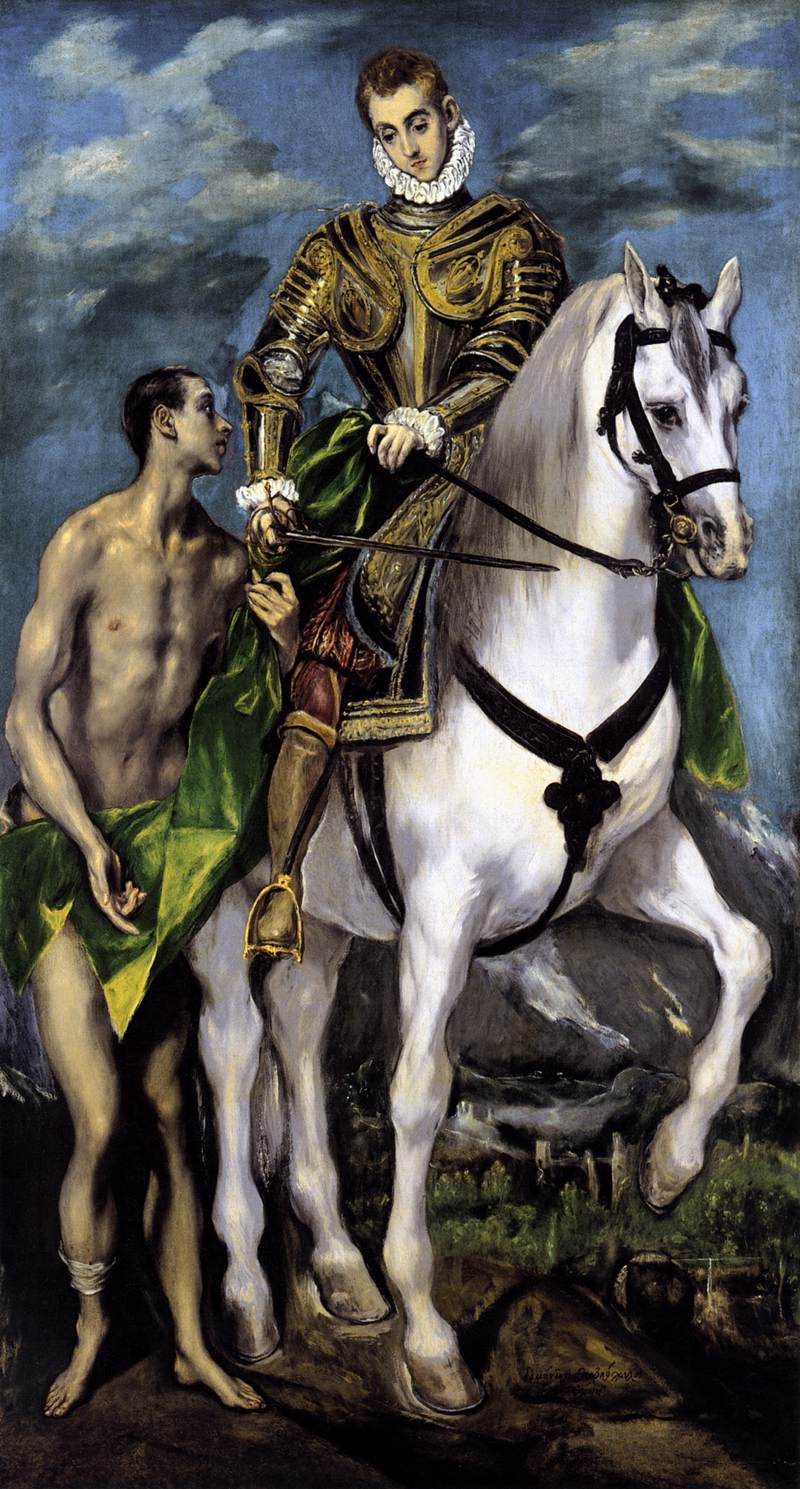
St Martin of Tours and the Beggar, El Greco
El Greco’s painting shows St Martin, still preparing for baptism, giving half of his large military cloak to a beggar. The following night Martin in his sleep saw Jesus Christ, surrounded by angels, and dressed in the half of the cloak he had given away.
God sometimes reveals himself in a mystical way to certain saints such as St Teresa of Avila and St John of the Cross. But most of the time these same saints met Jesus in the people they encountered in the ordinary course of daily life.
There is nothing wrong with you! All you ‘must do’ is to recognize God’s presence, and his personal love for you, in the people around you, those you know and those you meet in passing.
And, of course, we meet the Risen Lord Jesus in the Holy Sacrifice of the Mass and sacraments.
And the Word became flesh and dwelt among us (John 1:14).
Peace By Peace
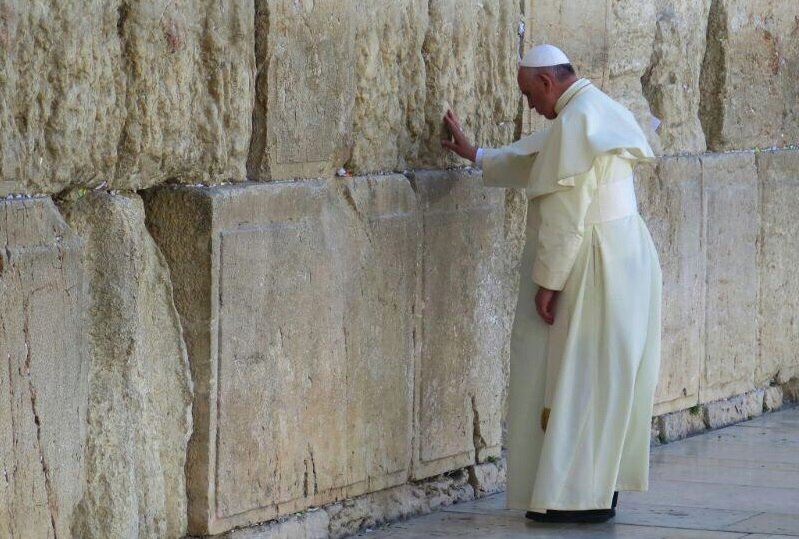
Pope Francis praying at the Western Wall, Jerusalem 2014 [Wikipedia]
All of us want peace. Many people build it day by day through small gestures and acts; many of them are suffering, yet patiently persevere in their efforts to be peacemakers. In 2017, may we dedicate ourselves prayerfully and actively to banishing violence from our hearts, words and deeds, and to becoming nonviolent people and to building nonviolent communities that care for our common home. Nothing is impossible if we turn to God in prayer. Everyone can be an artisan of peace.
– Pope Francis, Fiftieth World Day of Peace, 1 January 2017

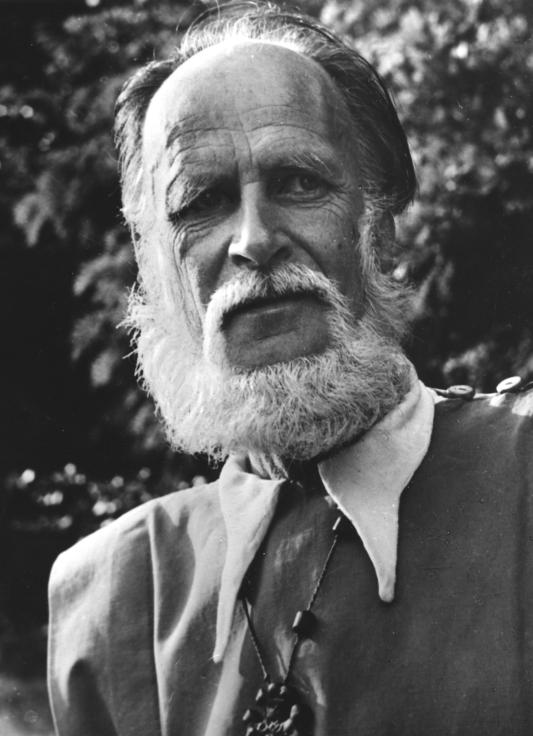
Lanza del Vasto
(1901- 1981) [Wikipedia]
Power can be used for any purpose,
but nonviolence or the power of justice can serve only justice.
– Lanza del Vasto, Founder of the Community of the Ark (1901-1981)

Jorge Mario Cardinal Bergoglio, Archbishop of Buenos Aires, now Pope Francis speaks about St Francis de Sales
The King of Glory does not reward his servants according to the dignity of the offices they hold but according to the love and humility with which they fulfill their offices.
– St Francis de Sales, Bishop of Geneva, Doctor of the Church (1567-1622)

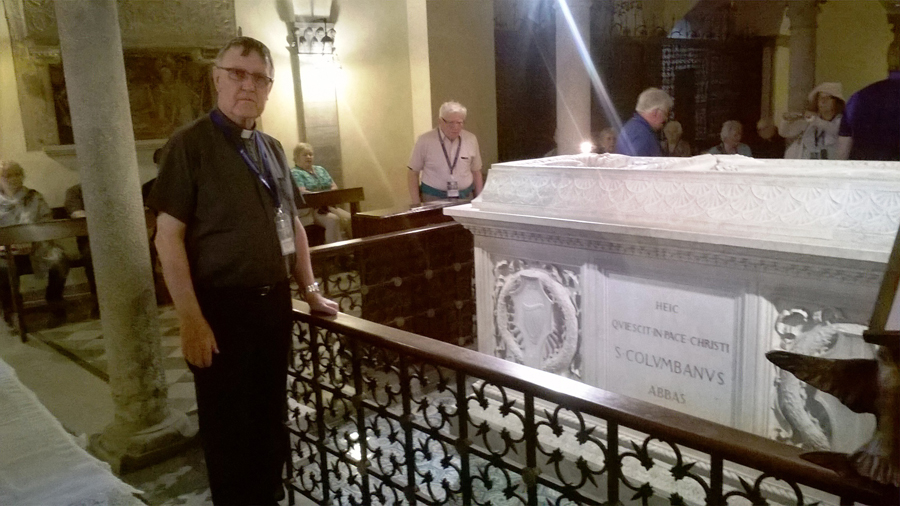
Your editor at the tomb of St Columban, Bobbio, Italy, June 2015
Men like nothing better than discussing and minding the business of others, passing superfluous comments at random and criticizing people behind their back. So those who do not have a discerning tongue should keep silent, or if they do say anything, it should promote peace.
– St Columban, Abbot (563-615)

Statue in St Raymond’s Cemetery, Bronx, New York City [Wikipedia]
Live simply, so that all may simply live.
– St Elizabeth Ann Seton, wife, mother, convert, founder of Catholic Schools and community of women religious (1774-1821)

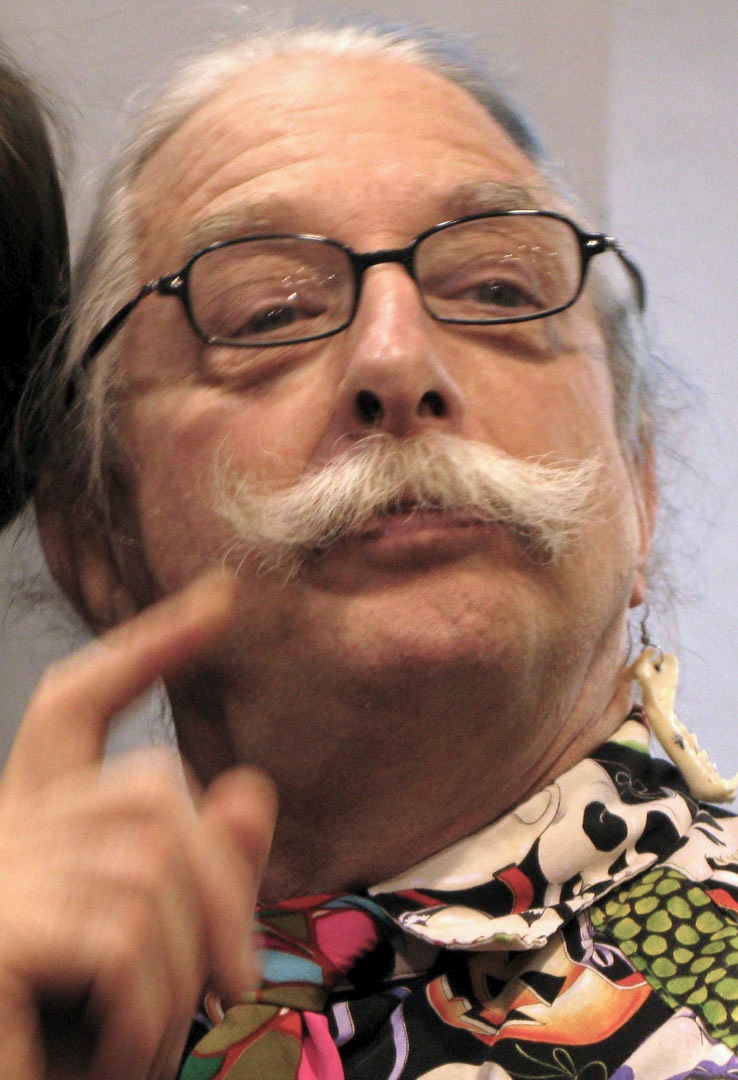
Dr Hunter Doherty ‘Patch’ Adams [Wikipedia]
It's the job of the clown and the doctor to walk towards suffering and not be afraid to speak up. As soon as you stop being part of peace and justice and care, you're going to be lonely and your life isn't going to have meaning.
You're not going to feel like your life has meaning unless you're giving. There you have it. Everyone makes choices. I try to lead by example. To say, look, I'm just doing my version. Everyone has to find their own version of loving. If you want meaning and you don't want to be lonely, be loving. Be your style and you might end up in a motorcycle gang, or you might end up in a nunnery, or you might end up in an extended family. Who knows; it doesn't matter. But at least within your tribe, think peace and justice and care.
If you want to prevent extinction then you have to think it for everybody.
– Patch Adams, The World of Dr Patch Adams and Gesundheit!
Dr Patch Adams . . . Taking Laughter Seriously [Rome Reports TV News Agency]

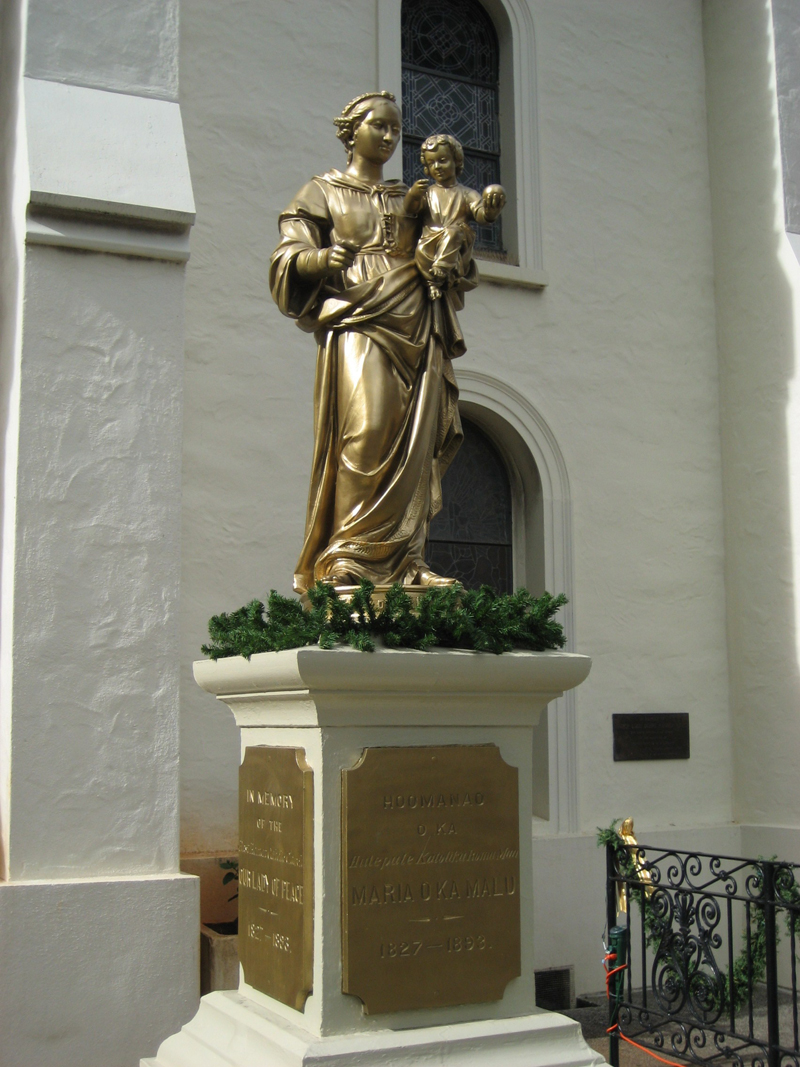
Our Lady of Peace, Cathedral of Our Lady of Peace, Honolulu [Wikipedia]
Nothing seems more appropriate and valuable to Us than to have the prayers of the whole Christian family rise to the Mother of God, who is invoked as the Queen of Peace, begging her to pour forth abundant gifts of her maternal goodness in midst of so many great trials and hardships
– Blessed Pope Paul VI, Christi Matri, September 15, 1966
Our Lady of Peace Center, Amman, Jordan
A project of the Latin Patriarchate of Jerusalem
Facebook
